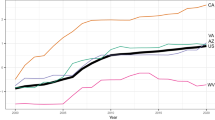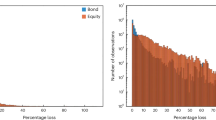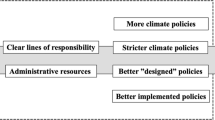Abstract
Central banks have begun to examine and manage climate risks, including both transition risks of moving from fossil fuels to clean energy and physical climate risks. Here we provide a systematic assessment of how and why central banks address climate risks on the basis of an original dataset of central banks across the Organization for Economic Co-operation and Development and Group of 20. We show that central banks vary substantially in the extent to which they re-risk fossil fuel investments and physical risks and de-risk clean energy investments. Our analysis finds that central bank climate risk management is not associated with a country’s economic exposure to transition risks, but instead with its climate politics. The results suggest that central banks may not be solely independent risk managers but also actors that respond to political demands. As such, central banks may reinforce national decarbonization policy, while not correcting for the lack thereof.
This is a preview of subscription content, access via your institution
Access options
Access to this article via Institution of Civil Engineers Library is not available.
Access Nature and 54 other Nature Portfolio journals
Get Nature+, our best-value online-access subscription
$29.99 / 30 days
cancel any time
Subscribe to this journal
Receive 12 digital issues and online access to articles
$119.00 per year
only $9.92 per issue
Buy this article
- Purchase on SpringerLink
- Instant access to full article PDF
Prices may be subject to local taxes which are calculated during checkout






Similar content being viewed by others
Data availability
We created two datasets for this analysis. The first is a policy-specific dataset that includes the individual re-risking and de-risking policy measures for all central banks in our dataset. The second is a country-level dataset that aggregates the policy observations into aggregate re-risking and de-risking scores. This dataset also includes the independent variables for our regression analysis. Both datasets are described in Methods and in Extended Data Tables 1 and 2. We currently do not make the datasets publicly available owing to additional ongoing analysis by the authors, but we make them available upon reasonable request.
Code availability
We will provide the code for the regression analysis upon request.
References
IPCC Climate Change 2022: Mitigation of Climate Change (eds Shukla, P. R. et al.) (Cambridge Univ. Press, 2022).
Bolton, P., Despres, M., Pereira da Silva, L. A. & Svartzman, R. The Green Swan: Central Banking and Financial Stability in the Age of Climate Change (BIS, 2020).
Financial headwinds for renewables investors: what’s the way forward? IEA https://www.iea.org/commentaries/financial-headwinds-for-renewables-investors-what-s-the-way-forward (2023).
Geels, F. W. Socio-technical transitions to sustainability: a review of criticisms and elaborations of the multi-level perspective. Curr. Opin. Environ. Sustain. 39, 187–201 (2019).
Bhandary, R. R., Gallagher, K. S. & Zhang, F. Climate finance policy in practice: a review of the evidence. Clim. Policy 21, 529–545 (2021).
Battiston, S., Monasterolo, I., Riahi, K. & van Ruijven, B. J. Accounting for finance is key for climate mitigation pathways. Science 372, 918–920 (2021).
Gabor, D. The (European) derisking state. State Mercato 43, 53–84 (2023).
Oman, W., Salin, M. & Svartzman, R. Three tales of central banking and financial supervision for the ecological transition. Wiley Interdiscip. Rev. Clim. Change 15, e876 (2024).
Svartzman, R., Bolton, P., Despres, M., Pereira Da Silva, L. A. & Samama, F. Central banks, financial stability and policy coordination in the age of climate uncertainty: a three-layered analytical and operational framework. Clim. Policy 21, 563–580 (2021).
Gruenewald, S., Knijp, G., Schoenmaker, D. & Van Tilburg, R. Embracing the brave new world: a response to Demekas and Grippa. J. Financ. Reg. 10, 127–134 (2024).
Babic, M. Green finance in the global energy transition: actors, instruments, and politics. Energy Res. Soc. Sci. 111, 103482 (2024).
Thiemann, M., Büttner, T. & Kessler, O. Beyond market neutrality? Central banks and the problem of climate change. Finance Soc. 9, 14–34 (2023).
Durrani, A., Rosmin, M. & Volz, U. The role of central banks in scaling up sustainable finance—what do monetary authorities in the Asia–Pacific region think? J. Sustain. Finance Invest. 10, 92–112 (2020).
Quorning, S. The ‘climate shift’ in central banks: how field arbitrageurs paved the way for climate stress testing. Rev. Int. Political Econ. 31, 74–96 (2023).
Campiglio, E. et al. Climate change challenges for central banks and financial regulators. Nat. Clim. Change 8, 462–468 (2018).
Dikau, S. & Volz, U. Central bank mandates, sustainability objectives and the promotion of green finance. Ecol. Econ. 184, 107022 (2021).
D’Orazio, P. & Popoyan, L. Fostering green investments and tackling climate-related financial risks: which role for macroprudential policies? Ecol. Econ. 160, 25–37 (2019).
D’Orazio, P. & Popoyan, L. Do monetary policy mandates and financial stability governance structures matter for the adoption of climate-related financial policies? Int. Econ. 173, 284–295 (2023).
Baer, M., Campiglio, E. & Deyris, J. It takes two to dance: institutional dynamics and climate-related financial policies. Ecol. Econ. 190, 107210 (2021).
DiLeo, M., Rudebusch, G. D. & van’t Klooster, J. Why the Fed and ECB Parted Ways on Climate Change: the Politics of Divergence in the Global Central Banking Community, Working Paper No. 88 (Hutchins Center, 2023).
Basel Committee on Banking Supervision. Principles for the Effective Management and Supervision of Climate-Related Financial Risks (BIS, 2022).
McConnell, A., Yanovski, B. & Lessmann, K. Central bank collateral as a green monetary policy instrument. Clim. Policy 22, 339–355 (2022).
Goodhart, L. M. Brave new world? Macro-prudential policy and the new political economy of the federal reserve. Rev. Int. Political Econ. 22, 280–310 (2015).
Caldecott, B. et al. Stranded Assets: a Climate Risk Challenge (IDB, 2016).
Smets, F. Financial stability and monetary policy: how closely interlinked?. Int. J. Cent. Bank. 10, 263–300 (2014).
Central Bank Governance and Financial Stability: a Report by a Study Group (BIS, 2011).
von Dulong, A., Gard-Murray, A., Hagen, A., Jaakkola, N. & Sen, S. Stranded assets: research gaps and implications for climate policy. Rev. Environ. Econ. Policy 17, 161–169 (2023).
Battiston, S., Mandel, A., Monasterolo, I., Schütze, F. & Visentin, G. A climate stress-test of the financial system. Nat. Clim. Change 7, 283–288 (2017).
Blinder, A. S. Central Banking in Theory and Practice (MIT, 1999).
Young, K. Policy takers or policy makers? The lobbying of global banking regulators. Bus. Horiz. 56, 691–701 (2013).
Jabko, N. & Kupzok, N. Indirect responsiveness and green central banking. J. Eur. Public Policy 31, 1026–1050 (2024).
Qanas, J. & Sawyer, M. ‘Independence’ of central banks and the political economy of monetary policy. Rev. Political Econ. 36, 565–580 (2023).
Bordo, M. D. A Brief History of Central Banks (Federal Reserve Bank of Cleveland, 2007).
Tooze, A. Debating Central Bank Mandates, Working Paper No. 01-2022 (Forum for a New Economy, 2022).
Tooze, A. The Death of the Central Bank Myth (Foreign Policy, 2020).
Özgöde, O. The emergence of systemic risk: the Federal Reserve, bailouts, and monetary government at the limits. Socio-Econ. Rev. 20, 2041–2071 (2022).
van’t Klooster, J. & Fontan, C. The myth of market neutrality: a comparative study of the European Central Bank’s and the Swiss National Bank’s corporate security purchases. New Political Econ. 25, 865–879 (2020).
Blyth, M. Structures do not come with an instruction sheet: interests, ideas, and progress in political science. Persp. Pol. 1, 695–706 (2003).
Hielscher, K. & Markwardt, G. The role of political institutions for the effectiveness of central bank independence. Eur. J. Political Econ. 28, 286–301 (2012).
Fernández-Albertos, J. The politics of central bank independence. Annu. Rev. Polit. Sci. 18, 217–237 (2015).
Macchiarelli, C., Monti, M., Wiesner, C. & Diessner, S. The European Central Bank between the Financial Crisis and Populisms (Palgrave Macmillan, 2020).
Lockwood, E. The Global Politics of Central Banking: a View from Political Science (Cornell Univ., 2016).
Adolph, C. Bankers, Bureaucrats, and Central Bank Politics: The Myth of Neutrality (Cambridge Univ. Press, 2013).
Nordhaus, W. D. The political business cycle. Rev. Econ. Stud. 42, 169–190 (1975).
Tooze, A. A Decade after the World Bailed out Finance, It’s Time for Finance to Bail out the World (Foreign Policy, 2019).
Papoutsi, M., Piazzesi, M. & Schneider, M. How Unconventional Is Green Monetary Policy? (International Monetary Fund, 2022).
Behnam, R. & Litterman, B. Managing Climate Risk in the US Financial System (Commodity Futures Trading Commission, 2020).
The Enhancement and Standardization of Climate-Related Disclosures for Investors, Federal Register, Vol. 89 (Securities and Exchange Commission, 2024).
Andonova, L. B., Hale, T. N. & Roger, C. B. National policy and transnational governance of climate change: substitutes or complements? Int. Stud. Q. 61, 253–268 (2017).
GDP (current US$) The World Bank Open Data https://data.worldbank.org/indicator/NY.GDP.MKTP.CD (2024).
EDGAR—The Emissions Database for Global Atmospheric Research (European Commission, 2024); https://edgar.jrc.ec.europa.eu/report_2023#data_download
Green monetary and financial policies (GMFP) tracker. E-axes Forum https://e-axes.org/tableau_iframe/policy-visualization/ (2021).
Renewable energy. OECD Data https://data.oecd.org/energy/renewable-energy.htm (2022).
Domestic Credit to Private Sector (% of GDP) (The World Bank Group, 2023); https://data.worldbank.org/indicator/FS.AST.PRVT.GD.ZS
Financial Depth. Global Financial Development Report (The World Bank Group, 2016); https://www.worldbank.org/en/publication/gfdr/gfdr-2016/background/financial-depth
Global Resource Input–Output Assessment. GLORIA Model (Industrial Ecology Virtual Laboratory, 2023); https://ielab.info/labs/ielab-gloria
Notre Dame global adaptation initiative (ND-Gain). Exposure component of country index. University of Notre Dame https://gain.nd.edu/our-work/country-index/methodology/ (2024).
Climate Actions and Policies Measurement Framework (OECD & IPAC, 2022); https://oecd-main.shinyapps.io/climate-actions-and-policies/
Global warming’s six audiences. Yale Program on Climate Change Communication https://climatecommunication.yale.edu/publications/global-warmings-six-audiences-a-cross-national-comparison/ (2023).
Dabla-Norris, E. et. al. Public Perceptions of Climate Mitigation Policies: Evidence from Cross-Country Surveys. Staff Discussion Note (International Monetary Fund, 2023).
DataBank. The World Bank Group https://databank.worldbank.org (2023).
Garriga, A. C. Central bank independence in the world: a new dataset. Int. Interact. https://doi.org/10.1080/03050629.2016.1188813 (2016).
Acknowledgements
We are grateful for feedback from R.O. Keohane and members of the Energy and Environment Policy Lab at the University of California, Berkeley. J.M. acknowledges funding from the Climate Program of the Berkeley Economy and Society Initiative and the USDA National Institute of Food and Agriculture, Hatch Project (accession no. 1020688).
Author information
Authors and Affiliations
Contributions
E.S. conceived the study and led the development of theory and corresponding analysis, with the guidance of J.M. and J.J.F; E.S. collected the data, designed the methodology, executed the statistical analysis and produced tables and figures, with the guidance of J.M. and J.J.F.; and E.S. and J.M. wrote the paper.
Corresponding authors
Ethics declarations
Competing interests
The authors declare no competing interests.
Peer review
Peer review information
Nature Energy thanks Sajid M. Chaudhry, Anna Geddes Geddes and Friedemann Polzin for their contribution to the peer review of this work.
Additional information
Publisher’s note Springer Nature remains neutral with regard to jurisdictional claims in published maps and institutional affiliations.
Extended data
Supplementary information
Supplementary Information
Supplementary Notes 1–11, Figs. 1–8 and Tables 1–13.
Rights and permissions
Springer Nature or its licensor (e.g. a society or other partner) holds exclusive rights to this article under a publishing agreement with the author(s) or other rightsholder(s); author self-archiving of the accepted manuscript version of this article is solely governed by the terms of such publishing agreement and applicable law.
About this article
Cite this article
Shears, E., Meckling, J. & Finnegan, J.J. How central banks manage climate and energy transition risks. Nat Energy 10, 470–478 (2025). https://doi.org/10.1038/s41560-025-01724-w
Received:
Accepted:
Published:
Issue Date:
DOI: https://doi.org/10.1038/s41560-025-01724-w



